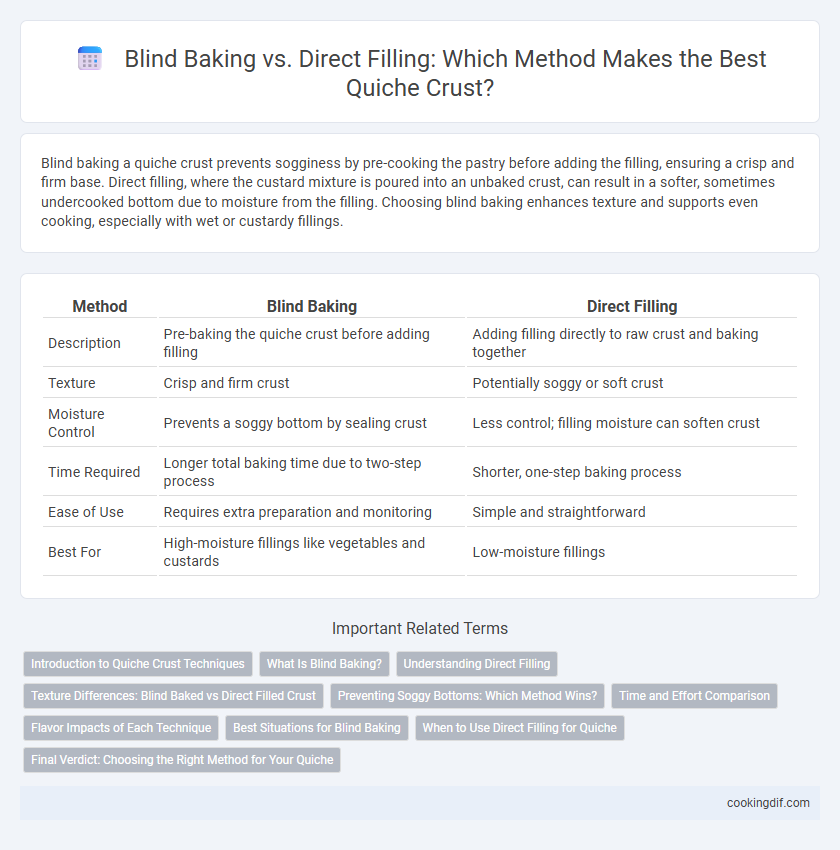Blind baking a quiche crust prevents sogginess by pre-cooking the pastry before adding the filling, ensuring a crisp and firm base. Direct filling, where the custard mixture is poured into an unbaked crust, can result in a softer, sometimes undercooked bottom due to moisture from the filling. Choosing blind baking enhances texture and supports even cooking, especially with wet or custardy fillings.
Table of Comparison
| Method | Blind Baking | Direct Filling |
|---|---|---|
| Description | Pre-baking the quiche crust before adding filling | Adding filling directly to raw crust and baking together |
| Texture | Crisp and firm crust | Potentially soggy or soft crust |
| Moisture Control | Prevents a soggy bottom by sealing crust | Less control; filling moisture can soften crust |
| Time Required | Longer total baking time due to two-step process | Shorter, one-step baking process |
| Ease of Use | Requires extra preparation and monitoring | Simple and straightforward |
| Best For | High-moisture fillings like vegetables and custards | Low-moisture fillings |
Introduction to Quiche Crust Techniques
Blind baking quiche crust involves pre-baking the dough to prevent sogginess from wet fillings, ensuring a crisp and sturdy base. Direct filling means placing the mixture into the raw crust and baking together, which can result in a softer, sometimes undercooked bottom. Choosing between these techniques depends on the moisture content of the filling and the desired crust texture in the finished quiche.
What Is Blind Baking?
Blind baking is the process of pre-baking a quiche crust without the filling to ensure a crisp, fully cooked base that prevents sogginess. This technique involves lining the crust with parchment paper and filling it with pie weights or dried beans to maintain its shape during baking. Blind baking is essential when using wet fillings or custards, as it creates a sturdy shell that holds up against moisture, resulting in a perfectly textured quiche.
Understanding Direct Filling
Direct filling for quiche crust involves pouring the custard mixture directly into an unbaked dough shell, allowing the crust and filling to cook simultaneously. This method saves time and results in a tender crust that absorbs some flavors from the filling but may risk a soggy base if the custard is too wet. Understanding direct filling helps optimize baking techniques to achieve a balanced texture between the crispness of the crust and the creaminess of the filling.
Texture Differences: Blind Baked vs Direct Filled Crust
Blind baking a quiche crust results in a firmer, flaky texture by preventing sogginess from wet fillings, maintaining a crisp base throughout baking. Direct filling the crust leads to a softer, sometimes slightly chewy texture as the filling moisture seeps into the dough. Choosing blind baking preserves structural integrity and enhances the contrast between crust and creamy quiche filling.
Preventing Soggy Bottoms: Which Method Wins?
Blind baking quiche crust involves pre-baking the dough to create a crisp barrier that effectively prevents soggy bottoms by keeping moisture from the filling at bay. Direct filling, where the crust is filled and baked simultaneously, increases the risk of a soggy crust due to prolonged exposure to wet ingredients like eggs, cream, and vegetables. Professional bakers often prefer blind baking for quiches to ensure a firm, golden crust that maintains its texture against custard-based fillings.
Time and Effort Comparison
Blind baking a quiche crust requires pre-baking the pastry for 15-20 minutes to ensure a crisp, fully cooked base, which adds extra time and effort but prevents sogginess. Direct filling involves pouring the custard directly into an unbaked crust, saving time but risking a soggy bottom and unevenly cooked pastry. The trade-off between these methods centers on time saved versus achieving an optimal texture and structure in the finished quiche.
Flavor Impacts of Each Technique
Blind baking a quiche crust creates a crisp, golden base that enhances the overall texture and prevents sogginess, concentrating flavors by allowing the crust to toast evenly. Direct filling results in a softer crust where the custard infuses the dough, creating a moister texture but potentially diluting the distinct buttery richness of the crust. The flavor impact of blind baking emphasizes a pronounced, caramelized crust taste, while direct filling offers a harmonious blend between filling and pastry.
Best Situations for Blind Baking
Blind baking quiche crust is ideal when using high-moisture fillings or custards, as it prevents sogginess by ensuring the crust is fully cooked before adding the liquid mixture. This technique is particularly effective for recipes containing watery vegetables like spinach or mushrooms, which release moisture during baking. Using pie weights during blind baking helps maintain the crust's shape and promotes even cooking, resulting in a crisp, firm base perfect for delicate quiche fillings.
When to Use Direct Filling for Quiche
Direct filling for quiche crust is ideal when using a sturdy dough with a high fat content, such as pate brisee or puff pastry, which can hold up to moisture and maintain structure during baking. This method suits recipes with less liquid quiche fillings or those containing pre-cooked ingredients that do not require lengthy baking times. Avoid direct filling when the crust is delicate or when a soggy bottom is a concern; in such cases, blind baking ensures a crisp, fully cooked crust.
Final Verdict: Choosing the Right Method for Your Quiche
Blind baking a quiche crust ensures a crisp, fully cooked base that prevents sogginess from wet fillings, making it ideal for custard-rich quiches or when using ingredients that release moisture. Direct filling offers convenience and a softer, more integrated crust texture, suitable for quiches with less liquid or pre-cooked fillings. The final verdict depends on the recipe's moisture content and desired crust texture, with blind baking favored for a flaky, sturdy shell and direct filling preferred for a tender, cohesive crust.
blind baking vs direct filling for quiche crust Infographic

 cookingdif.com
cookingdif.com